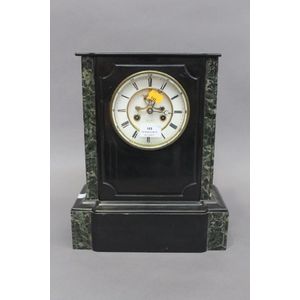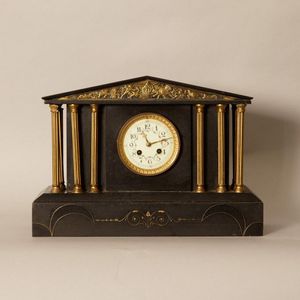19th Century Ansonia Temple Mantel Clock
You must be a subscriber, and be logged in to view price and dealer details.
Subscribe Now to view actual auction price for this item
When you subscribe, you have the option of setting the currency in which to display prices to $Au, $US, $NZ or Stg.
- Chapter Ring - A separate metal plate on the face of a clock, on which the numerals for the hours and sometimes parts of the hours, are displayed, usually wheel shaped and sitting on top of the dial plate. The chapter ring is often a feature of the clock and can be silvered or enamelled to stand as a contrast to its background. The hours are usually shown in Roman numerals, although in the late 19th and earlt 20th century, Arabic numerals became fashionable.
- Pendulum - The pendulum was discovered around 1602 by Galileo Galilei, and was adopted for time keeping by the Dutch mathematician and natural philosopher, Christiaan Huygens, who excelled in astronomy, physics, and horology.
The pendulum comprises a metal rod usually of brass or steel with a metal disk, known as a bob, at the end. The movement of the pendulum is driven by weights or a spring, and as a pendulum swings in a regular arc, it was found accuracy could be controlled to within a few seconds a week.
Timekeeping can be adjusted by changing the height of the bob on the rod, making the pendulum either swing slower or faster.
The disadvantage of the pendulum was that changes in temperature also changed the length of the pendulum, interfering with the accuracy of the clock, and so in the 18th century two types of mercurial pendulums were invented which countered the movement in the steel rod.
The pendulum was the world's most accurate timekeeping technology until the invention of the quartz clock, regulated by a quartz crystal, in 1927.
This item has been included into following indexes:
- Ansonia (United States) - clocks, maker or retailer 315
-
clocks, material or decoration
- marble or slate, black 342
- slate 344
Visually similar items

An Ansonia mantel clock, architectural case with six columns, on plinth base (not working, key & pendelum). Height 29 cm

French C: 19th slate and marble cased mantle clock, with eight day striking movement, together with pendulum, height 34 cm

Antique French black and green marble mantle clock 'Levy Aron', has key & pendulum (in office), 36 cm high, 30 cm wide

Early black slate mantel clock. Enamelled face, rouge columns. Key and pendulum available; works short periods but unserviced - as inspected. Height 39 cm
